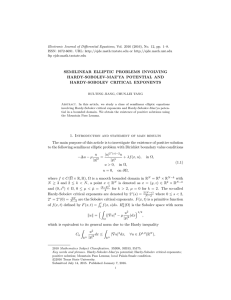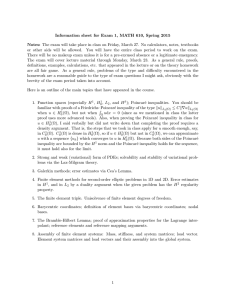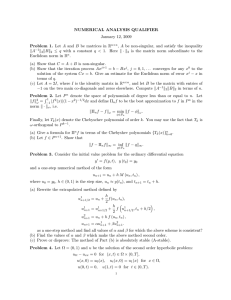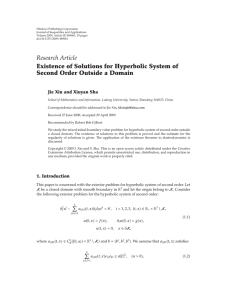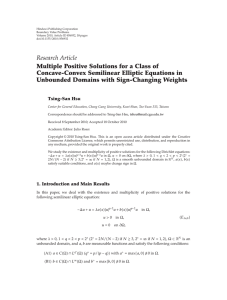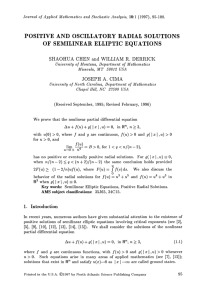ON THE EXISTENCE OF A POSITIVE SOLUTION
advertisement
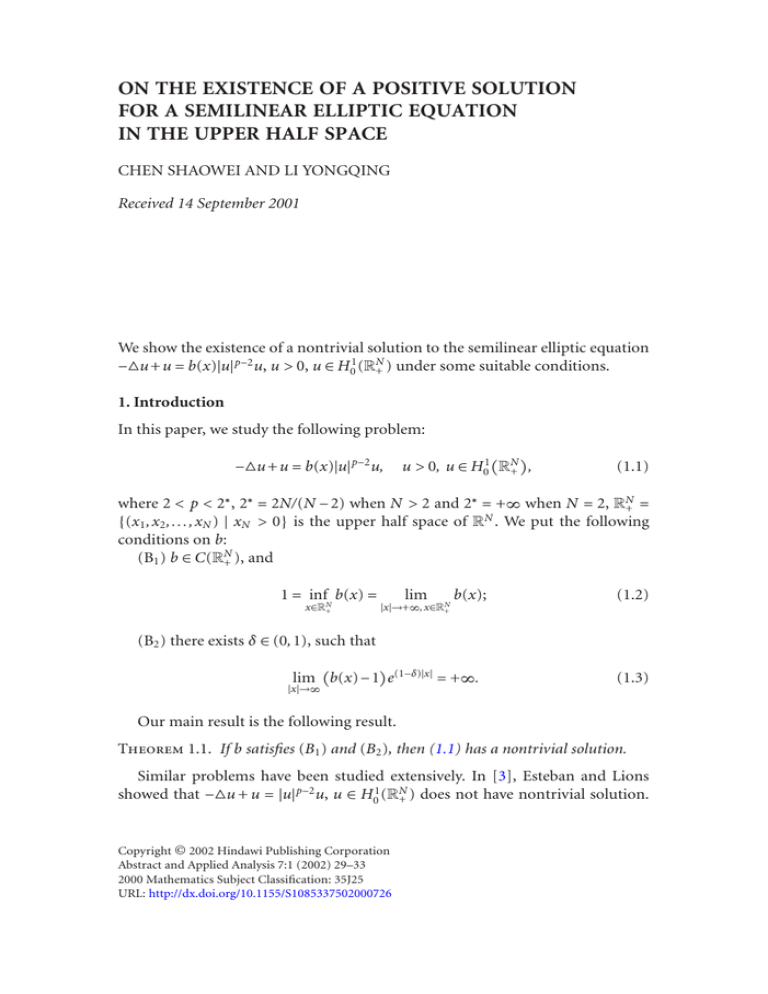
ON THE EXISTENCE OF A POSITIVE SOLUTION
FOR A SEMILINEAR ELLIPTIC EQUATION
IN THE UPPER HALF SPACE
CHEN SHAOWEI AND LI YONGQING
Received 14 September 2001
We show the existence of a nontrivial solution to the semilinear elliptic equation
−u + u = b(x)|u| p−2 u, u > 0, u ∈ H01 (RN
+ ) under some suitable conditions.
1. Introduction
In this paper, we study the following problem:
−u + u = b(x)|u| p−2 u,
u > 0, u ∈ H01 RN+ ,
(1.1)
where 2 < p < 2∗ , 2∗ = 2N/(N − 2) when N > 2 and 2∗ = +∞ when N = 2, RN+ =
{(x1 , x2 , . . . , xN ) | xN > 0} is the upper half space of RN . We put the following
conditions on b:
(B1 ) b ∈ C(RN+ ), and
1 = infN b(x) =
x∈R+
lim
|x|→+∞, x∈RN
+
b(x);
(1.2)
(B2 ) there exists δ ∈ (0, 1), such that
lim b(x) − 1 e(1−δ)|x| = +∞.
|x|→∞
(1.3)
Our main result is the following result.
Theorem 1.1. If b satisfies (B1 ) and (B2 ), then (1.1) has a nontrivial solution.
Similar problems have been studied extensively. In [3], Esteban and Lions
showed that −u + u = |u| p−2 u, u ∈ H01 (RN+ ) does not have nontrivial solution.
Copyright © 2002 Hindawi Publishing Corporation
Abstract and Applied Analysis 7:1 (2002) 29–33
2000 Mathematics Subject Classification: 35J25
URL: http://dx.doi.org/10.1155/S1085337502000726
30
Positive solutions in upper half space
However, with the help of the potential b(x) and the comparison technique derived in [2], we proved the existence of a nontrivial solution to problem (1.1).
2. Proof of Theorem 1.1
Let
ϕ(u) =
RN
+
1
1
1
|∇u|2 + |u|2 dx −
2
2
p
RN
+
b(x)|u| p dx.
(2.1)
Lemma 2.1. Denote S p = inf u∈H01 (RN ), |u| p =1 u2 . Then
inf
u∈H01 (RN
+ ), |u| p =1
u 2 = S p .
p/(p−2)
Lemma 2.2. If 0 < c < c∗ := (1/2 − 1/ p)S p
(2.2)
, then ϕ satisfies (PS)c condition.
One can see [2] or [5] for the proof of Lemmas 2.1 and 2.2.
Lemma 2.3. The equation −u + u = |u| p−2 u has a unique positive solution w in
RN and satisfies the following conditions:
(i) w > 0 in RN , w ∈ C ∞ (RN ).
(ii) w(x) = w(|x|).
(iii) w(r)r (N −1)/2 exp(r) → C > 0 and w (r)r (N −1)/2 exp(r) → −C, where r =
|x| → +∞.
Proof. See [1, 4].
Proof of Theorem 1.1. By Lemma 2.2, we need only to prove that the Mountain
Pass value of ϕ,
c = inf
1 1
−
2 p
v 2
RN
+
b(x)|v| p dx
p/(p−2)
2/ p
; v ∈ H01 RN+ , v = θ , (2.3)
satisfies that 0 < c < c∗ .
Set
1,
ψn (x) = n − |x|,
0,
|x| ≤ n − 1,
n − 1 < |x| ≤ n,
|x| > n.
(2.4)
Let xn = (0, 0, . . . , 0, n), un = ψn (· − xn )w(· − xn ). Then un ∈ H01 (RN+ ), n = 1, 2, . . . .
C. Shaowei and L. Yongqing 31
Notice that
2
u n =
RN
=
RN
∇un 2 dx +
∇ ψn · −xn w · −xn 2 dx +
=
B(θ,n)
∇ ψn · w 2 dx +
=
u2n dx
RN
|∇ω|2 dx +
B(θ,n−1)
Bn−1,n
Bn−1,n
+2
Bn−1,n
RN
+
∇ψn 2 · ω2 dx
(2.5)
Bn−1,n
RN
|∇ω| dx +
Bn−1,n
∇ψn 2 · ω2 dx +
+
Bn−1,n
RN \B(θ,n−1)
ψn2 · |∇ω|2 dx + 2
+
ψn2 · ω2 dx
ω2 dx
2
RN \B(θ,n−1)
ψn · −xn w · −xn 2 dx
ψn · w 2 dx
ω · ψn · ∇ω · ∇ψn dx +
|∇ω|2 dx +
RN
ω2 dx
ψn2 · |∇ω|2 dx +
+
=
B(θ,n)
B(θ,n−1)
Bn−1,n
|ω|2 dx
ω · ψn · ∇ω · ∇ψn dx
Bn−1,n
ψn2 · ω2 dx,
where Bn−1,n = B(θ, n) \ B(θ, n − 1).
From Lemma 2.3 we know that, when n is big enough,
|∇ω| dx = C1
2
RN \B(θ,n−1)
≤ C1
+∞
n−1
2 N −1
ω (r) · r
dr
+∞
n−1
(2.6)
e
−2r
dr =
C1
e2(n−1)
.
Similarly, when n is big enough, we get
ω dx ≤
2
RN \B(θ,n−1)
C2
e2(n−1)
.
(2.7)
So
2
u n = ω 2 + O
1
e2(n−1)
.
(2.8)
32
Positive solutions in upper half space
Let a(x) = b(x) − 1. Then
RN
+
p
b(x)un dx =
p
un dx +
RN
+
RN
+
p
=
B(θ,n−1)
Bn−1,n
RN
|ω| dx +
B(θ,n−1)
a(x + xn )|ω| p dx
+
=
p
a(x)un dx
+
Bn−1,n
(2.9)
|ω| p dx +
p
a(x + xn )ψn (x) · ω(x) dx
B(θ,n−1)
a(x + xn )|ω| p dx
p
a(x+xn ) ψn (x) · ω(x) dx+
RN \B(θ,n−1)
|ω| p dx.
Thus
RN \B(θ,n−1)
|ω| p dx = o
1
p
a(x + xn ) ψn (x) · ω(x) dx = o
Bn−1,n
,
e2(n−1)
1
e2(n−1)
(2.10)
.
From (B2 ), we see that there exists a positive constant λ, such that
a(x) ≥
λ
.
e(1−δ)|x|
(2.11)
So there exists a positive constant C3 , such that
RN
+
p
b(x)un dx ≥
RN
|ω| p dx +
C3
.
e2(1−δ)(n−1)
(2.12)
Then
RN
+
p
b(x)un dx
≥
2/ p
RN
|ω| p dx +
=
RN
|ω| p dx
=
p
RN
|ω| dx
2/ p
C3
e2(1−δ)(n−1)
2/ p 1+
2/ p 1+
C4
2(1
−
e δ)(n−1)
C5
e2(1−δ)(n−1)
(2.13)
2/ p
+o
1
e2(1−δ)(n−1)
.
C. Shaowei and L. Yongqing 33
Thus
2
un p 2/ p = dx
N b(x) un
R+
ω 2
RN
ω p dx
2/ p
−
C6
e
+o
2(1−δ)(n−1)
1
e2(1−δ)(n−1)
. (2.14)
So
2
u n p 2/ p < dx
N b(x) un
R+
ω 2
RN
ω p dx
2/ p ,
(2.15)
when n is big enough.
Thus, we come to the conclusion that
c<
1 1 p/(p−2)
−
S
.
2 p p
(2.16)
Acknowledgement
This work was supported in part by the National Natural Science Foundation
and the Fujian Province Natural Science Foundation of China.
References
[1]
[2]
[3]
[4]
[5]
H. Berestycki and P.-L. Lions, Nonlinear scalar field equations. I. Existence of a ground
state, Arch. Rational Mech. Anal. 82 (1983), no. 4, 313–345.
W. Y. Ding and W. M. Ni, On the existence of positive entire solutions of a semilinear
elliptic equation, Arch. Rational Mech. Anal. 91 (1986), no. 4, 283–308.
M. J. Esteban and P.-L. Lions, Existence and nonexistence results for semilinear elliptic
problems in unbounded domains, Proc. Roy. Soc. Edinburgh Sect. A 93 (1982/83),
no. 1-2, 1–14.
B. Gidas, W. M. Ni, and L. Nirenberg, Symmetry and related properties via the maximum principle, Comm. Math. Phys. 68 (1979), no. 3, 209–243.
M. Willem, Minimax Theorems, Progress in Nonlinear Differential Equations and
Their Applications, vol. 24, Birkhäuser, Massachusetts, 1996.
Chen Shaowei: Department of Mathematics, Fujian Normal University,
Fuzhou, Fujian 35007, China
Li Yongqing: Department of Mathematics, Fujian Normal University, Fuzhou,
Fujian 35007, China
E-mail address: yqli@pub1.fz.fj.cn


